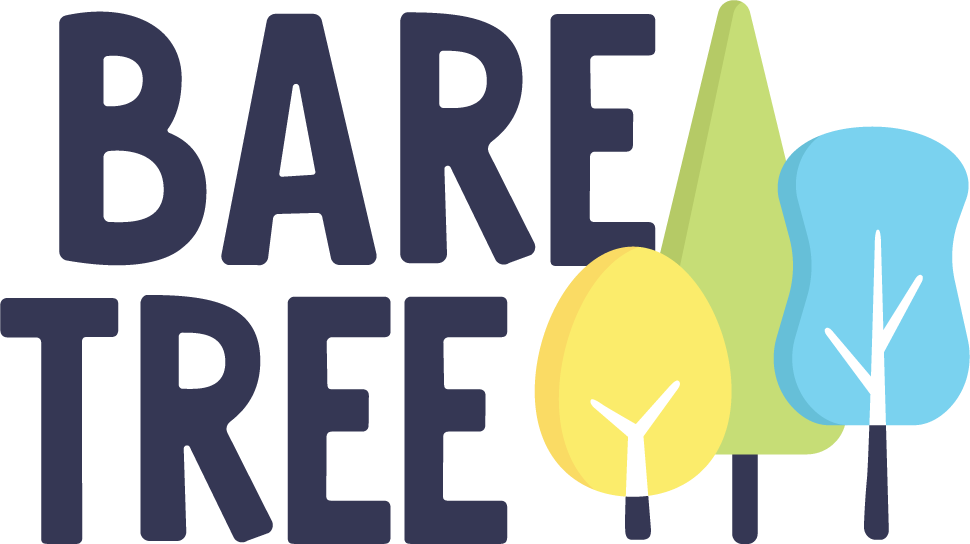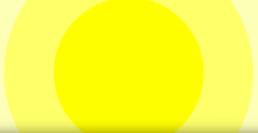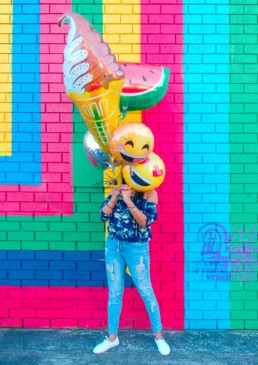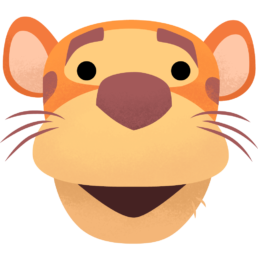The Best of Snap Summit 2020
Like most recent events, this year’s Snapchat Summit was adapted virtually as opposed to existing in a physical space; it might seem like a no-brainer for a company whose expertise is in the digital realm—but if anything, this year’s summit has proven Snapchat’s ambition of bridging the gap between between augmented reality, and reality.
If the theme of Snapchat up until now has been “show, don’t tell” the mantra they’ve adopted moving forward seems to be “experience, don’t show”. What this means for brands is that Snapchat has uniquely positioned itself to allow artists & studios to create unique, branded AR experiences that transcend the digital sphere.
Below I’ve highlighted the features that I’m most excited about, as well as how they can be utilized to elevate users’ AR experiences.
Local Lenses:
These dynamic lenses use real-life locations (whole areas or specific buildings) to create a unified AR experience that different Snapchatters can share, as long as they’re in the same physical space—the first of its kind. In the example above, multiple people are creating a mural of different colors on one shared space using multiple phones. This added expertiental element creates a unified experience that exists wholly online, but that facilitates physical community. This is the first best of both worlds experience.
 Photo courtesy of Snapchat.
Photo courtesy of Snapchat.
Snap Scan & Marker Lenses:
Scan Partners is a powerful tool for brands. It allows the camera to recognize an item and then attaches it to a specific lens. The examples Snapchat used were a plant-identifer that, when clicked, would provide information on how to care for that plant (including links to buy those items). But they can also be utilized by luxury brands in order to create beautiful AR experiences in the physical world, once again blending the 2. Louis Vuitton recently added their logo as a marker lens, which means that when their logo is scanned in real life in Snapchat, a virtual door to their latest showroom opens highlighting classic and current collections in a virtual showroom. Too-Faced marked their 'Born This Way' product packaging—so when scanned, users can try it on virtually. Marker lenses elimiate the need to advertise via Snapcode, as well—the product is the Snapcode.
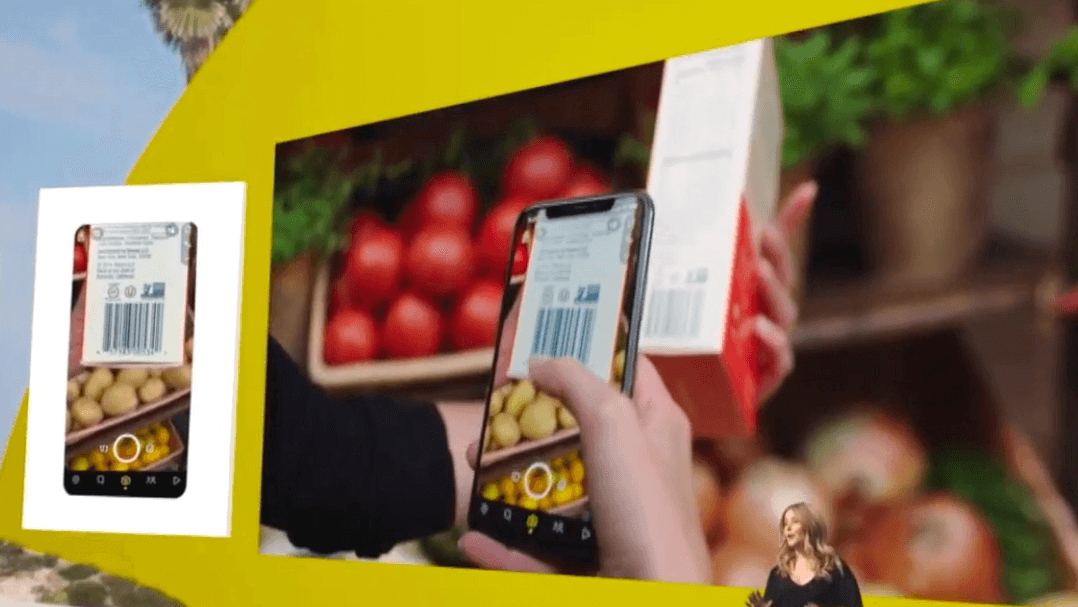
Photo courtesy of Snapchat.
SnapML:
The developer tool now features SnapM (or Snapchat Machine Learning), which lets developers bring their own machine-learning models to power Snap lenses, making what is possible to create limited only to the imagination. This allows for the creation of lenses that were previously impossible (such as the Van Gogh filter below, created by Nicholas Dominici) that would benefit anything from a new movie or video game with a singular aesthetic, to a museum wanting to highlight a current exhibition.
Additionally, this allows the creation of extremely accurate tracking of faces, gestures, feet, and even landmarks such as buildings. Below, you can see the practical application that Wannaby has used: they created a try-it-on filter that lets users see their newest shoe in a variety of colors (yes, that shoe is AR, not real).
In short, SnapML has destroyed many creative boundaries that previously existed—the new “brand experience” is limited (mostly) by what you can imagine vs by technology, as used to be the case.
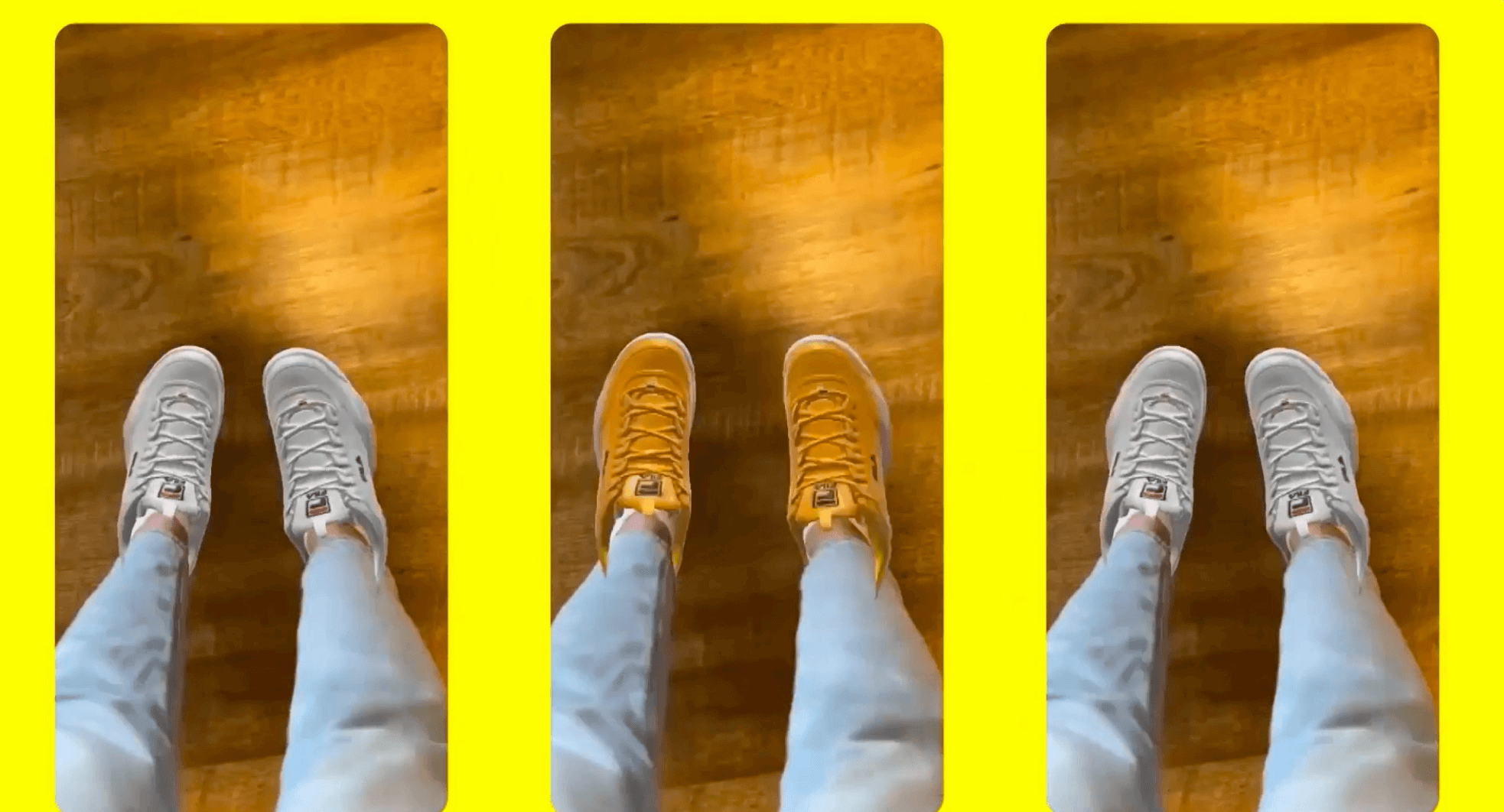 Photo courtesy of Snapchat.
Photo courtesy of Snapchat.
Places:
Snapchat is making it easier than ever to integrate call-to-actions with their app and lenses. One example of this is “Places”, which would lead to an outside-Snap call to action such as ordering a physical product online, whether it’s that new lipstick or food from their favorite delivery spot! This would be especially crucial for smaller businesses that need to receive local support.
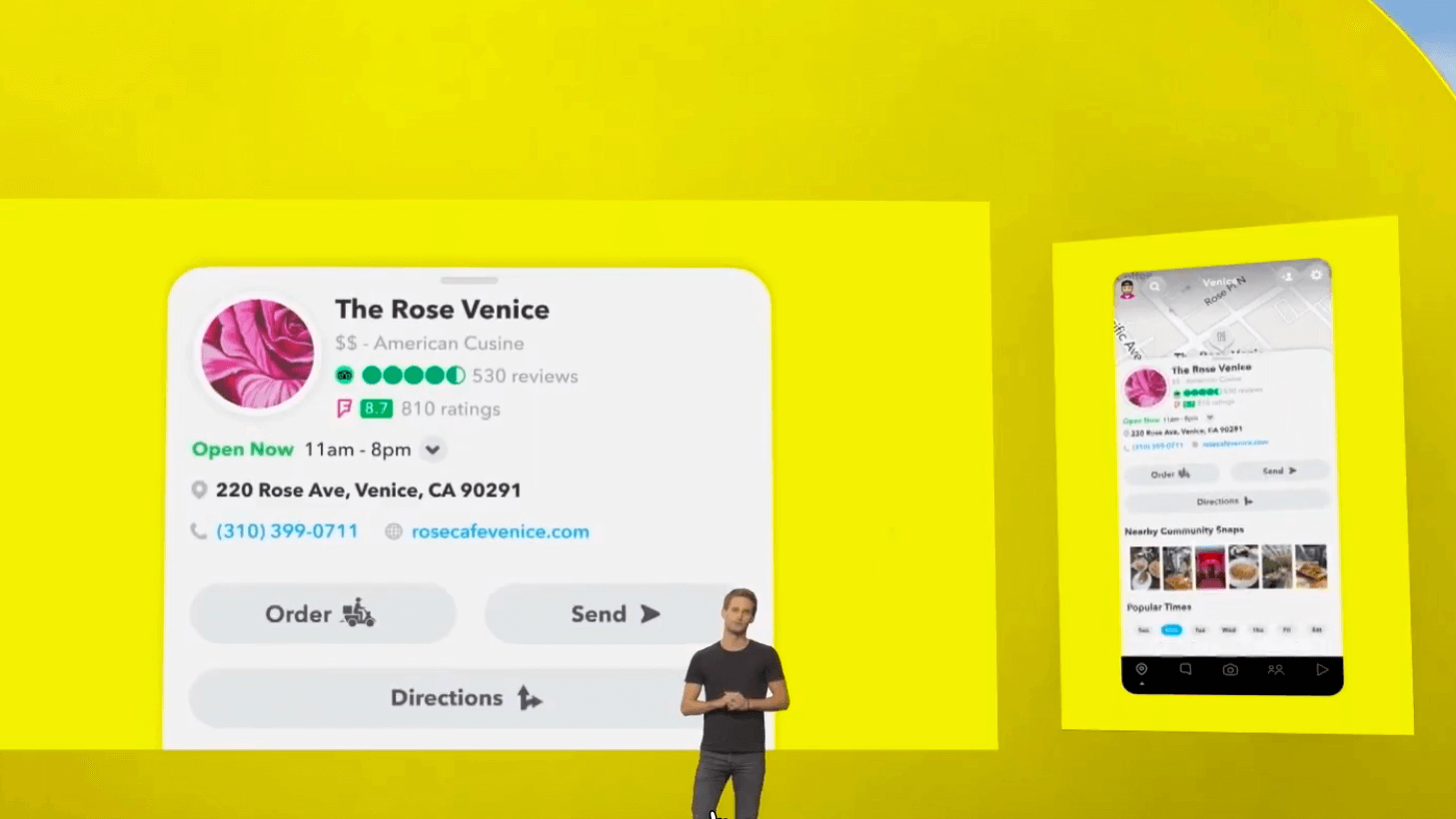 Photo courtesy of Snapchat.
Photo courtesy of Snapchat.
Integration SnapKits:
If your brand has an existing app, Snapchat will now let you integrate their technology with it in order to create a new layer of interaction with your fans. This is more abstract in thought, but can be applicable to any number of brands across any discipline—it’s an equally powerful tool both for those brands within the entertainment industry, and outside of it. Rally Road is an app that is meant for classic car investments, but has integrated Snapchat’s CreativeKit to let users purchase shares in rare items and share them with their friends in a unique AR environment. Atom movie tickets has also utilized this to let its users browse movies, purchase tickets, and choose seats together in one easy experience. There are numerous types of kits available, each with their own unique perks (AdKit, which makes monetizing apps easy with SnapAds, CreativeKit, which allows apps to bring real-time data into Snapchat, and CameraKit, which brings the power os Snapchat camera to your apps).
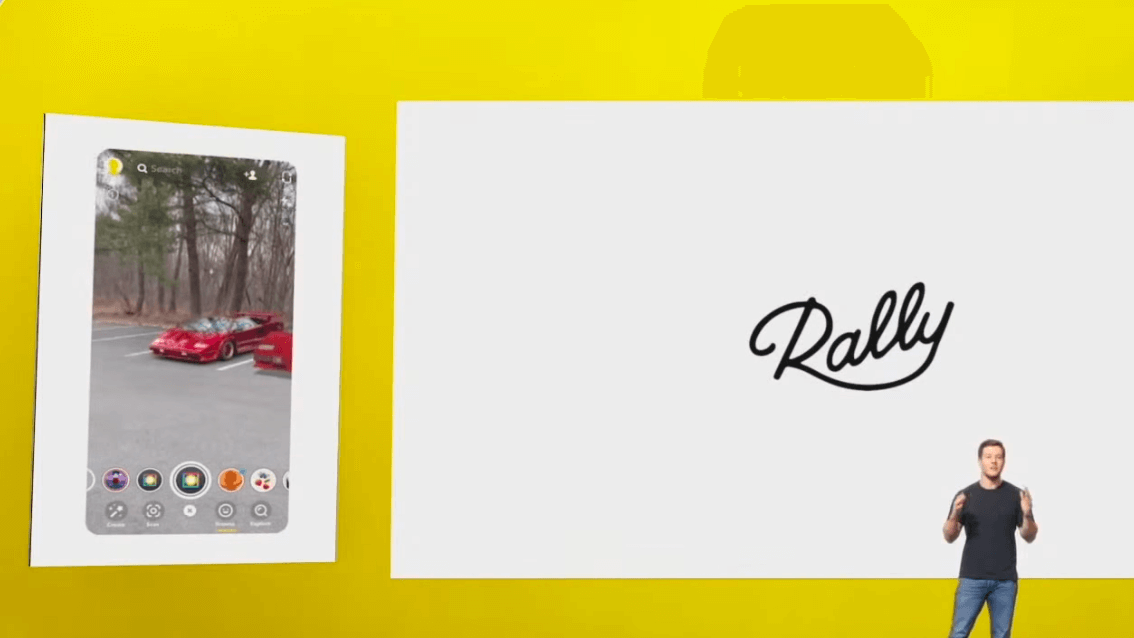 Photo courtesy of Snapchat.
Photo courtesy of Snapchat.
Where Do I Start?
If you're interested leveraging Snapchat for Any of the above uses, a qualified creative studio is your best bet, since we know the ins-and-outs of not only best creative practices to create an attractive filter, but can also help determine which strategy is the way to go when the options can seem endless and equally appealing (especially after this year's summit).
We here at Bare Tree Media would love to collaborate with any artist, strategist, or brand who's just as pumped about these new Snapchat features as we are! You can take a look to see the lenses we've already created.
Happy World Emoji Day 2018
It is 2018, and Emojis have taken over. The once perceived “silly, childish” messaging stickers have become completely integrated into our daily conversations. Snapchat filters even let us turn ourselves into our very own Bitmoji. Emojis allow us to demonstrate feelings and emotions to a greater specificity than our words. Here at Bare Tree Media, we pride ourselves on being the original and the longest-standing emoji designer. Day in and day out, we work to give everyone the ability to say just what they want (with OR without words 😉). It seems with each new day more emojis are created by designers across the globe providing each of us with unique ways to express ourselves or just have fun!
Apple’s Custom Emojis: Memoji
World Emoji Day calls for big news, and companies have delivered. Apple Inc. announced they will be releasing Emoji 11.0 for iOS and MacOS, an emoji pack including 66 new emojis for Apple fans to enjoy in late 2018. Along with these new emojis Apple is also releasing their Bitmoji counter, Memoji. The 3D emoji will be available with iOS 12 this fall. Memoji’s are to follow-up Apple’s animated stickers that use facial recognition to overlay animal filters, Animojis. Memoji’s take the next step and allow users to create and use their custom Emoji stickers to express themselves in a unique audio-visual hybrid. With innovations like these, developers are reimagining where and how emojis can exist, proving the only way is up.
Facebook's Emoji Keyboard Stays Strong
Facebook and their messenger are one of the leaders in the emoji space, having adopted all 2,800 Unicode Emojis. Unicode is a consortium of the biggest tech companies and a few countries, who decide on what should or should not be an emoji. Facebook once again proudly released their annual Emoji statistics, demonstrating significant increases in emoji use and engagement. Here are just some of the numbers:
- Over 5 billion emojis are sent everyday in Messenger
- 900 million emojis are sent on Messenger that don’t even have text
- 700 million emojis are used in Facebook posts everyday
- The 😂emoji is the most popular around the world
- The ❤️emoji has doubled in usage in the past year
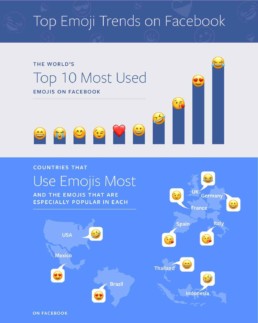
Twitter Branded Emojis
Emojis have made their mark on our society, and now large companies are working towards making their own mark through branded emoji stickers.
Recently, Twitter teamed up with Disney to release custom emojis of the upcoming movie Christopher Robin and chose us to create them! Each of core 100 Acre Woods characters got their own little emoji to accompany their hashtag. Tweets including #ChristopherRobin, #Pooh, #Tigger, #Eeyore and #ItsPiglet grew in number. Twitter users that might not have engaged with tweets involving the Christopher Robin movie in a normal situation began tweeting about the movie. Some solely so that they could have the emojis on their feed!
Emoji Merchandise
There are now emoji clothing, pillows, an Emoji Movie, and now premiering tonight in New York City, “EmojiLand: The Musical” on Broadway just a couple theaters down from The Lion King. Many companies have realized the power of emojis, and how developing new emojis allows for each company to integrate themselves in a language rapidly growing in popularity. No one truly knows the future of emojis, but we do know it’s bright. 🌟
Join Us and Share Your Favorite Emoji with Bare Tree Media on Facebook, Twitter and Instagram!
